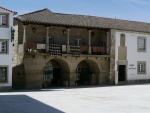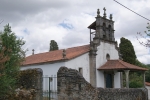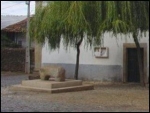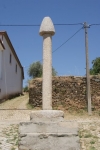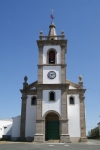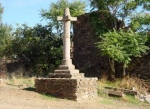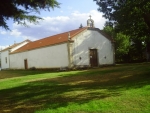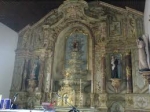DirectoryENG
- BRIDGES AND SIDEWALKS (5)
- CASTLE (6)
- CRUISE
- EMBLAZONED HOUSE (8)
- FOUMTAIN (2)
- HISTORIC BUILDING (6)
- MANOR HOUSE (1)
- PILLORY (14)
- RUINS
- SQUARE (1)
- TRACE RUPESTRES (2)
Description: The museum exhibits collections of cultural and ethnographic art and artists of this region; it gathers a sample of the life in the villages of Miranda. All this region is a live museum, with unique characteristics and own culture, that are expressed in its own language (mirandês), in the dances and music, the theater, the popular religiousness, the gastronomy, the economy and the form peoples life who live in the field and on agriculture.
Date: 14th century (conjectural) / Modern Age
Description: Mannerist church with a rectangular plan, with a rectangular porch. It has a single nave. All elevations are covered by a basement and cornice with wedges topped by spires. The interior space has walls plastered and painted blue. The choir has wooden balustrades and stairs on the Epistle Side. You can see four side chapels of perfect arches, the access to the choir and the churchyard and the holy water font.
State of Conservation: good.
Source: Património dos Concelhos da Terra Fria Concelho de Bragança VOLUME II
Dated: Proto-historic or Roman.
Description: zoomorphic sculpture that represents a porcine carved in granite, with 1.34 m long.
State of Conservation: bad.
Source: Património dos Concelhos da Terra Fria Concelho de Bragança VOLUME II
Date: 12th and 14th centuries
Classification: building of public interest – IIP (Dec. nº23 122, DG 231 de 11 Outubro1933).
Description: pillory of “coluço” built on two quadrangular steps, with snap basis to the forend. This element is cylindrical, has no decoration and is topped by a pyramidal cone.
State of conservation: reasonable.
Source: Património dos Concelhos da Terra Fria Concelho de Bragança VOLUME II
Dating: it may have been built or rebuilt in 1757.
Description: access to this large temple is done by a wide staircase. In the churchyard there is a church garden sink of holy water from the ruined Chapel of Santa Eulalia, where is said to have existed in the town of Medea. In the grand facade stands out the high Bell Tower of three records. Inside there are 9 altars carved polychrome; a pulpit; the baptistery of granite and the high altar with the national arms.
State of conservation: good.
Legends and Traditions: a house in the Fountain of the Moor Street, in the neighborhood of Pereiro, the memory remains the site of the old parish church. It is a stone with the date 1622. The main religious festivals of this village are from São Sebastião (on the 3rd Sunday of January), St. Apolinário (the last Sunday in July) and Nossa senhora da Assunção (15th of August). Here also conducts a biweekly (Wednesday) fair (8 and 26 of each month) and an annual fair (December 8).
Source: Património dos Concelhos da Terra Fria Concelho de Bragança VOLUME II
Dating: the 15th century (probable date of its construction).
Classification: VC (Dec. nº29/90, DR 163 de 17 Julho 1990).
Description: bridge of 5 perfect round arches, being the centre one the largest, whose foundations are based directly on the ground. The crowning of the guards is made of stone with rounded top and remaining part of these with carved stone placed upwards. Has 30.6 meters long, maximum height of 5 meters. The floor is a type Portuguese sidewalk.
State of conservation; good.
Source: Património dos Concelhos da Terra Fria Concelho de Bragança VOLUME II
Date: 13th and 14th century.
Classification: building of public interest (Dec. nº23 122, DG 231 de 11 Outubro 1933).
Description: this pelourinho “bragançano type” has a quadrangular recent framework that accompanies the slope of the terrain, is based on two quadrangular steps and features a base of the same format. The cylindrical stem is composed of two stones and from its top depart four cruciform arms, topped by a truncated conical pyramid.
State of Conservation: reasonable.
Source: Património dos Concelhos da Terra Fria Concelho de Bragança VOLUME II
Date: 14th century
Classification: building of public interest – IIP (Dec. nº23 122, DG 231 de 11 Outubro1933).
Description: cone pillory resting on three square steps of different heights made in shale. The column base is composed of an octagonal truncated pyramid, oblong with 80 cm high, which stands under the octagonal shaft with a smooth surface. There is a truncated pyramid with rectangular base with four worn Shapes.
State of conservation: reasonable.
Location: Macedo do Mato
Source: Património dos Concelhos da Terra Fria Concelho de Bragança VOLUME II
Date: 18th century (conjectural).
Description: this site as well the sanctuary, consists of eight entrances representing the Calvary, is also the source of “Engaranhos” with some imperceptible inscriptions.
State of conservation: reasonable.
Legends and traditions: the people believe that the source of the “Engaranhos” has the power to cure people suffering from problems of growth, speech and locomotion. In May 1932, the Abade de Baçal discovered several prehistoric inscriptions on a rock near the fountain of 2Engaranhos”, belonging quite possibly to a roman castro. They also say that in Serapicos are hidden treasures and enchanted Moorish women. The pilgrimage of Nossa Senhora do Aviso is celebrated on the first Sunday of June.
Location: Serapicos, Bragança
Source: Património dos Concelhos da Terra Fria Concelho de Bragança VOLUME II
Dating: Church of medieval roots, rebuilt in the late 18th century.
Description: the entrance may be earlier than the reconstruction of the Church, in the late 18th century. The inside features a ship of plain walls. In the background, on the side of the Gospel, is the baptismal Chapel and further arise the north side access door and two Windows. On the side of the Epistle is the pulpit with a railing of carved rocaille, which accesses by stairs located in the sacristy. The chancel, of rectangular plan has granite slabs on the ground, two Windows, and walls covered with lime.
State of Conservation: good.
Location: Parada, Bragança
Source: Património dos Concelhos da Terra Fria Concelho de Bragança VOLUME II

